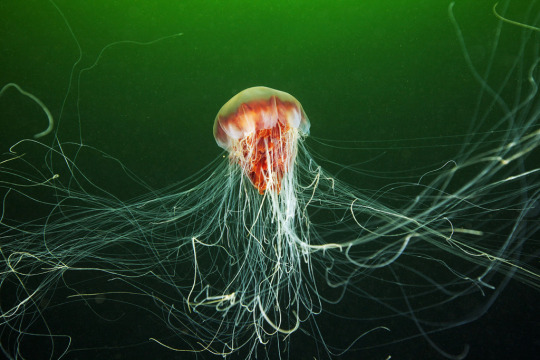Cryptid Profile: Giant Jellyfish
In 1953, a deep-sea diver from Australia witnessed something that absolutely shocked and terrified him. While deep below the surface, the diver noticed a large dark mass off in the distance that appeared to be floating within the current of the ocean. Stunned at what he was seeing, the diver continued to watch the dark mass get closer. At that moment, a Whitetip Shark swam within the vicinity of the mass. Without warning, the shark began to thrash around as if it was being attacked by some unseen predator. Eventually the shark went still and the diver watched in horrific amazement as the dark mass began to pull the body into its center. It was at this moment that the deep-sea diver realized what he was looking at. There in front of him at a safe distance away, was a Giant Jellyfish.
Currently, the largest known jellyfish in the world is the Lion’s Mane Jellyfish (Cyanea capillata). The bell diameter (the “head”) of the Lion’s Mane can grow to over 6ft 7in wide, while the sticky tentacles can grow up to 100ft long. These jellyfish are found primarily within the cold waters of the Arctic, Northern Atlantic, and Northern Pacific oceans. The largest specimen of Lion’s Head washed up in Massachusetts Bay in 1870, and had a bell diameter of 7ft and tentacle length of 121ft.
Now, could a Lion’s Mane Jellyfish be the Jelly responsible for catching, killing, and “eating” the shark in Australia? While the L.M.J is capable of growing extremely long tentacles, the bell diameter is not large enough to encapsulate and digest a full grown whitetip shark. The generally agreed upon length of the shark is around 9.8ft long, although a record setting 13ft specimen has been caught before. This would make the shark bigger than the bell of the L.M.J. by almost 3ft. In order for a jellyfish to eat and digest its food, it needs to fully encapsulate the prey inside its “stomach”. The stomach of the jellyfish is known as the coelenteron, a single cavity inside the bell which serves as not only the stomach, but also as the mouth, intestines, and anus. When the food has fully made it inside the coelenteron, digestive enzymes and acids begin to break down the food and it is then absorbed into the body. But, if the food is larger than the small hole that leads inside the coelenteron, the jelly will release the food to drift away.
This means that the jellyfish that caught and ate the whitetip shark had to possess a bell which was 12ft or wider. In turn, this could mean that the tentacles of this mysterious gigantic jelly might have been a length of over 200ft or more.
Seeing as how the diver only saw this creature once, could this have just been a rare, one of its kind jelly? More than likely not. A second sighting of a Giant Jellyfish took place in November of 1969, 14miles southwest of Bermuda. Divers Richard Winer and Pat Boatwright reported seeing a giant purplish colored jellyfish with an almost pink outer bell rim pulsating through the water. They estimated the bell diameter as being between 50-100ft. Then, 4yrs later in 1973, an Australian ship by the name of Kuranda collided with a Giant Jellyfish while making its way through the South Pacific near Fiji. The bell of the giant jelly wrapped around the head of the ship, while the tentacles wrapped around and flailed along both sides. The captain of the ship, Langley Smith, estimated the tentacles to be over 200ft long. The bell of the jelly basically exploded upwards onto the deck and left a slimy goo that measured 2ft deep. A tugboat by the name of Hercules was called to assist in the removal of the dead creature. Samples taken of the jelly were tested and the results came back as belonging to a Lion’s Mane Jellyfish.
So, could there be gigantic jellyfish currently pulsating along in the oceans of the world? Yes. Jellies tend to grow larger the deeper you go in the ocean, so it is not unbelievable that there could be a massive subspecies of L.M.J alive out there just waiting to be officially discovered. Humankind is discovering new sea creatures regularly so it’s only a matter of time before something truly gigantic is witnessed by scientists. The only thing we recommend though is that if you do go out looking for Gigantic Jellyfish, try and keep a safe distance away. It would be a shame to finally discover one of these things alive, only to end up inside it, slowly digesting into its body, and never getting to tell this world of its discovery.
-The Pine Barrens Institute
*Image Credit: Google
*Side-note: I know many of you will instantly exclaim that you have seen photos of divers alongside gigantic jellyfish in ocean before. For that, I will respond by stating that these are not photos of gigantic jellies, these are actually photos of normal jellyfish up close to the camera while another diver is offset in the distance. A forced perspective photograph can easily make a normal sized creature appear to be monstrous when it is anything but. Also, Photoshop can easily be blamed for some of these photos as well. Sorry!

